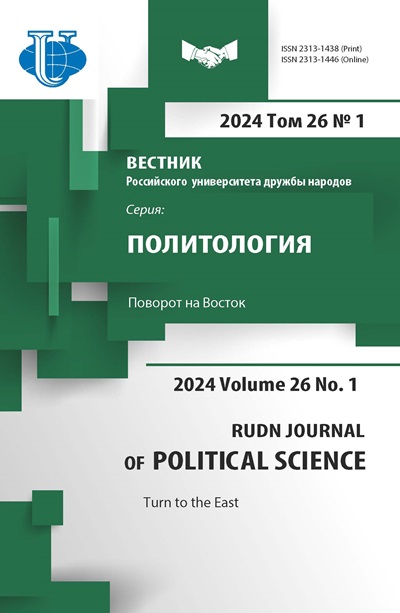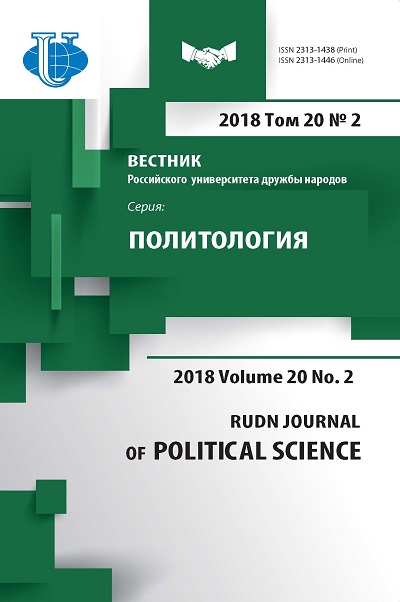ISLAM IN XINJIANG AS A FACTOR OF POLITICAL INSTABILITY IN PEOPLE’S REPUBLIC OF CHINA
- Authors: Mavlonova A.S.1
-
Affiliations:
- National Research University Higher School of Economics
- Issue: Vol 20, No 2 (2018)
- Pages: 176-186
- Section: Political processes in the modern world
- URL: https://journals.rudn.ru/political-science/article/view/19063
- DOI: https://doi.org/10.22363/2313-1438-2018-20-2-176-186
Cite item
Full Text
Abstract
Separatism in the Xinjiang Uygur Autonomous Region of People’s Republic of China is a very complex, multifaceted, multidimensional, multifactorial and, at the same time, little-studied problem. This article is devoted to the consideration of the religious factor as one of the factors along with a number of others provoking political instability in the Xinjiang. Given the heterogeneity of Xinjiang, an analysis was conducted of the various zones in the region, which have their own specific characteristics. So, the author came to the conclusion that it is the religious factor that is most pronounced in the Western and Southern zones. Radically-minded separatists, who use elements of the Wahhabi ideology in their political programs, have a fairly serious weight here. And the speeches in these parts of Xinjiang come from the Ferghana Valley. And in this region, anti-Chinese actions, unlike the population of Urumqi and Kuldja, often occur with the slogans of Islamic liberation. Regarding the political and legal situation of Muslims in Xinjiang, although freedom of religion is guaranteed at the official level, in practice, such legislative acts define narrow legal boundaries for religious activities, and they allow state bodies to strictly control and interfere in the sphere of religious relations. Nevertheless, there are not any additional requirements for professing Islam, the state also pays enough attention to the protection of Muslim cultural monuments, which are in large numbers in the Xinjiang.
Keywords
About the authors
Anna Sergeevna Mavlonova
National Research University Higher School of Economics
Author for correspondence.
Email: mavlonova.anna@yandex.ru
PhD, senior lecturer of National Research University Higher School of Economics
Myasnitskaya str., 20, Moscow, Russia, 101000References
- Buyarov D.V. Nekotoryye aspekty gosudarstvennogo regulirovaniya religioznoy sfery v Sin’tszyan-Uygurskom avtonomnom rayone. Teoriya i praktika obshchestvennogo razvitiya. 2015; 18. (In Russ.).
- Syroyezhkin K.L. Sin'tszyan: bol'shoy vopros dlya Kitaya i Kazakhstana. Almaty; 2015. (In Russ.).
- Chislennost’ naseleniya Respubliki Kazakhstan po otdel'nym etnosam na nachalo 2016 goda. Komitet po statistike Ministerstva natsional'noy ekonomiki RK. Available from: http://stat.gov.kz/ faces/wcnav_externalId/publBullS14-2016?_afrLoop=4033806516728711#%40%3F_afrLoop% 3D4033806516728711 % 26_adf.ctrl sostoyaniya% 3D12pqjjhd4h_17. (In Russ.).
- Clarke M. Looking West: China and Central Asia. Testimony before the U.S.-China Economic and Security Review Commission. 2015
- Finley J.S. The Art of Symbolic Resistance. Uyghur Identities and Uyghur-Han Relations in Contemporary Xinjiang. 2013
- Hodong Kim. Holy War in China: the Muslim Rebellion and State in Chinese Central Asia, 1864—1877. Stanford University Press; 2004.
- Michael E. Clarke. Xinjiang and China’s Rise in Central Asia, 1949—2009: A History. London: Routledge; 2011.
- Millward J., Tursun N. Political History and Strategies of Control 1884—1978 in China’s Muslim Borderland. New York: M.E. Sharp Publishers; 2004.
- 中华人民共和国宪法. Constitution of China. Available from: http://www.lawinfochina.com/ display.aspx?id=27574&lib=law. (In Chin.).
- 新疆的宗教信仰自由状况 [Xinjiang de zongjiao xinyang ziyou zhuangkuang]. Informatsionnoye agentstvo «Xinhua». Available from: http://news.xinhuanet.com/politics/201606/02/c_1118976926.htm. (In Chin.).
- 宗教活动场所设立审批和登记办法国家宗教事务局令 [Zongjiao huodong changsuo sheli shenpi he dengji bàn fà guojia zongjiao shiwu ju ling]. Available from: http://www.lawinfochina.com. (In Chin.).
- 宗教事务条例 [Zongjiao shiwu tiaoli]. Available from: http://www.lawinfochina.com. (In Chin.).
- 数据说话!新疆如何满足信教公民正常宗教需求? [Shuju shuohua! Xinjiang ruhe manzu xinjiao gongmin zhengchang zongjiao xuqiu?]. Available from: http://www.xinjiang.gov.cn/ 2016/06/03/50.html. (In Chin.).
- 新疆维吾尔自治区 2016 年国民经济和社会发展统计公报 [Xinjiang weiwuer zizhiqu 2016 nian guomin jingji he shehui fazhan tongji gongbao]. Official site of the government of China. Available from: http://www.xinjiang.gov.cn/2017/04/17/129362.html. (In Chin.).
- 年新疆 1%人口抽样调查主要数据公报 [2015 Nian xinjiang 1% renkou chouyang diaocha zhuyao shuju gongbao]. Statisticheskoye byuro SUAR KNR. Available from: http://www.xjtj.gov.cn/tjfw/dh_tjgb/201608/t20160801_509437.html. (In Chin.).
















